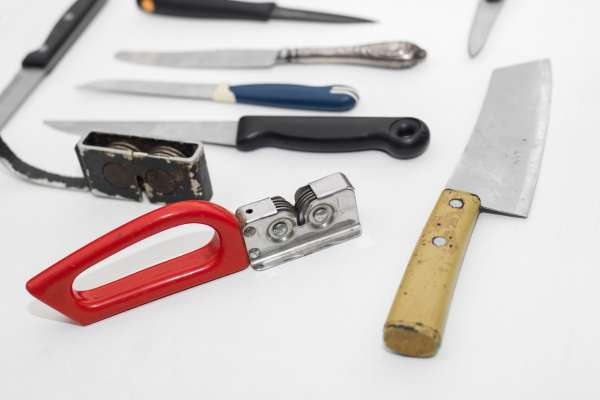Sharpening kitchen knives at home is an essential skill for any home cook, ensuring your blades remain effective and safe. Not only does it save you money on professional sharpening services, but it also enhances your culinary experience by making slicing, dicing, and chopping more efficient and enjoyable. Properly sharpened knives reduce the risk of accidents, as a sharp blade requires less force and provides better control. By learning how to sharpen kitchen knives at home, you can maintain your knives’ longevity and performance, keeping them in optimal condition for all your cooking needs. In this guide, we will explore the benefits, important techniques, and practical tips to help you master the art of knife sharpening.
How Often Should I Sharpen My Kitchen Knives?

It is generally recommended to sharpen your kitchen knives every 2-3 months with regular use. However, the frequency of sharpening may vary depending on how often you cook and the type of cutting tasks you perform. Signs that indicate your knives need sharpening include difficulty in slicing through food, a noticeable decrease in cutting performance, or visible nicks on the blade.
Can I Sharpen A Serrated Knife At Home?
Yes, it is possible to sharpen a serrated knife at home, but it can be more challenging than sharpening a regular straight-edged knife. Serrated knives have small teeth along the blade that require a specialized tool for sharpening. One option is to use a tapered round file or a serrated knife sharpener specifically designed for this purpose. It’s important to match the size of the file or sharpener with the size of the serrations on your knife to ensure effective sharpening.
Is It Safe To Use An Electric Knife Sharpener?

Using an electric knife sharpener can be safe as long as you follow the manufacturer’s instructions and take proper precautions. These devices are designed to make sharpening knives easier and more efficient, but it’s important to use them correctly to avoid any accidents or damage to your knives. Make sure to read the user manual carefully and always keep your hands away from the blade while the sharpener is in use.
Tools Needed For Sharpening
1. Sharpening Stones
Sharpening stones, also known as whetstones, are one of the most effective tools for sharpening a kitchen knife at home. These stones come in various grit levels, which determine the fineness of the edge they produce. Coarse grit stones are used for repairing damaged or very dull blades, while medium and fine grit stones are ideal for regular sharpening and refining the knife’s edge. Using a sharpening stone requires practice and patience, as maintaining the correct angle is crucial. However, once mastered, it provides a superior edge that can significantly improve your cutting precision and efficiency.
2. Honing Rods
Honing rods are another essential tool for keeping your kitchen knives sharp at home. Unlike sharpening stones, which remove metal to create a new edge, honing rods realign the existing edge of the blade. They are typically made of steel, ceramic, or diamond-coated materials. Regular use of a honing rod can prolong the time between sharpenings, ensuring your knives stay sharp and ready for use. By maintaining your knives with a honing rod, you can achieve a consistently sharp edge, enhancing your cooking experience and safety in the kitchen.
3. Electric Sharpeners
For those seeking convenience and speed, electric sharpeners are an excellent option for sharpening a kitchen knife at home. These devices are designed to quickly and efficiently sharpen blades with minimal effort. Electric sharpeners often feature multiple stages, including coarse and fine abrasive slots, allowing you to achieve a precise edge in a matter of minutes. While they may not offer the same level of control as abrasive stones, electric sharpeners are user-friendly and perfect for home cooks who want sharp knives without investing significant time and effort.
4. Manual Sharpeners
Manual sharpeners provide a balance between the control of sharpening stones and the convenience of electric sharpeners. These handheld devices typically feature angled slots with abrasive materials that help you achieve a sharp edge with a few strokes. Manual sharpeners are easy to use and require less skill than whetstones, making them a great option for beginners learning to sharpen kitchen knives at home. They are also portable and compact, making them a practical choice for quick touch-ups and maintenance. By using a manual sharpener, you can ensure your kitchen knives remain in excellent condition, ready for any culinary task.
Setting Up Your Workspace
Before you start to sharpen kitchen knives at home, it’s crucial to set up a proper workspace. Choose a well-lit area with a stable surface to prevent any accidents. Gather all the necessary tools, such as a sharpening stone, honing rod, and a damp cloth. Ensure the workspace is free from any clutter that might obstruct your movements. A secure and organized workspace not only makes the sharpening process smoother but also ensures your safety. Preparing your environment correctly allows you to focus entirely on the task, making the process of abrasive a kitchen knife at home both efficient and effective.
Using A Honing Rod
Using a honing rod is one of the simplest and most effective methods to sharpen a kitchen knife at home. A honing rod helps realign the knife’s edge, keeping it sharp and precise. To use it, hold the rod vertically with the tip firmly on the countertop. Position the knife at a 20-degree angle to the rod and gently swipe the blade from the base to the tip, alternating sides. Repeat this process several times. Honing regularly helps maintain the knife’s edge between more intensive abrasive sessions. By incorporating a honing rod into your routine, you can easily sharpen kitchen knives at home and extend their lifespan.
Purpose Of Honing
The purpose of honing is to maintain and straighten the edge of your knife, rather than to remove material and create a new edge, which is the goal of sharpening. Regular honing helps to keep your knives in peak condition, reducing the need for frequent abrasive. It’s an essential part of knife maintenance, ensuring that you can sharpen a kitchen knife at home with minimal effort. Honing realigns the microscopic teeth on the edge of the blade that can become misaligned with regular use. By understanding and utilizing the purpose of honing, you can keep your kitchen knives performing at their best, making your cooking tasks easier and more enjoyable.
Over-Sharpening
Over-sharpening can be a common pitfall when it comes to maintaining kitchen knives with a sharpening rod. While the intention may be to achieve razor-sharp edges, excessive sharpening can actually lead to damage and reduce the lifespan of your blades. It’s important to strike a balance between sharpness and durability, ensuring that you’re not removing too much material each time you sharpen.
Using Different Grits
Using different grits of sharpening stones is a proven technique for sharpening a kitchen knife at home. Start with a coarse grit stone to remove any nicks or dullness from the blade. Hold the knife at a 20-degree angle and slide it across the stone in a sweeping motion. Once the edge is formed, switch to a medium grit stone to smooth out the roughness. Finally, use a fine grit stone to polish and refine the edge to a razor-sharp finish. This method allows for precise sharpening and is ideal for maintaining high-quality knives.
Using A Coffee Mug
An unconventional yet effective method for how to sharpen kitchen knives at home involves using a coffee mug. The unglazed ceramic bottom of a coffee mug acts as a makeshift abrasive stone. Simply hold the knife at a 20-degree angle and draw the blade across the ceramic surface, maintaining consistent pressure. Repeat this process on both sides of the blade until you achieve a sharp edge. This method is particularly useful for quick touch-ups and maintaining the sharpness of your knives between more thorough sharpening sessions. Using a coffee mug is a convenient and cost-effective way to keep your kitchen knives in top condition without needing specialized equipment.
Sharpening With Sandpaper

Sharpening with sandpaper is another versatile method for how to sharpen kitchen knives at home. This technique requires sandpaper sheets with different grits, typically starting with a coarse 400 grit and progressing to finer grits such as 800 and 1200. Attach the sandpaper to a flat surface, such as a piece of wood or a glass pane, and secure it in place. Hold the knife at a consistent angle and draw the blade across the sandpaper, alternating sides to maintain an even edge. This method is particularly effective for restoring severely dull or damaged knives. Sharpening with sandpaper is a practical and inexpensive way to achieve professional-level sharpness at home, ensuring your kitchen knives are always ready for use.
The Final Thought
Sharpening kitchen knives at home is a simple and cost-effective way to maintain the sharpness and longevity of your blades. By following the steps outlined in this article, you can ensure that your knives remain in top condition for all your culinary needs. Remember to regularly hone your knives between sharpenings to keep them performing at their best. With practice and patience, anyone can master the art of knife sharpening and enjoy the benefits of having sharp, efficient tools in the kitchen.

